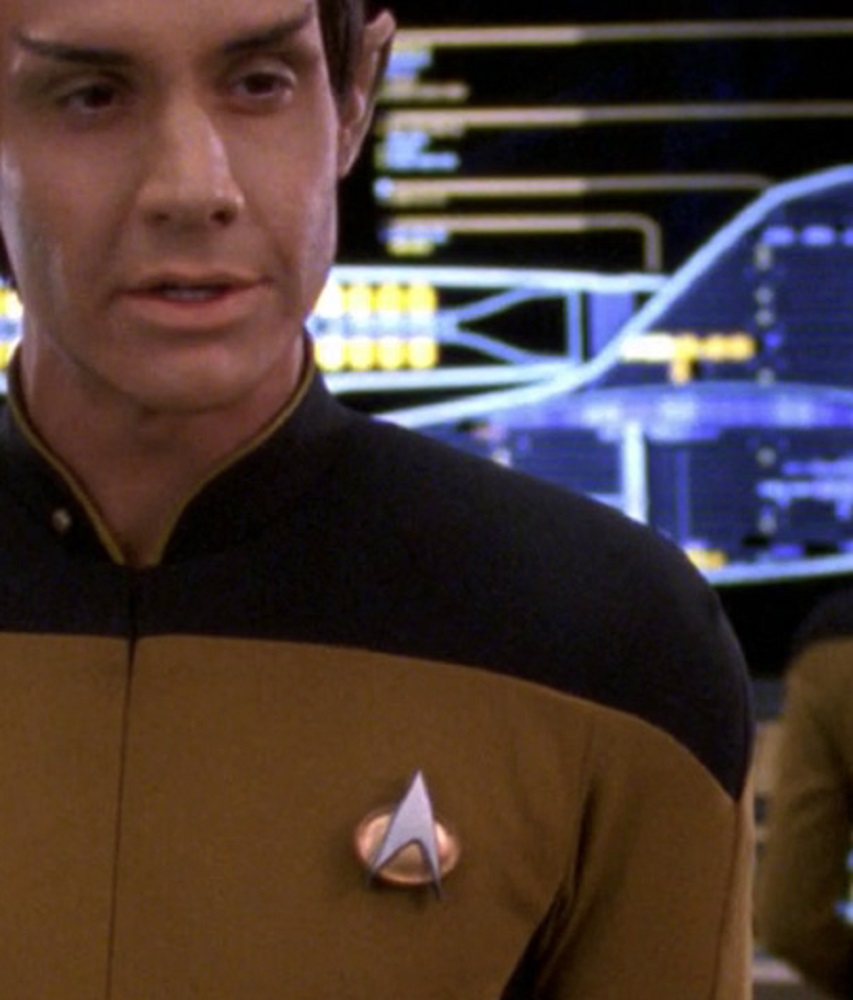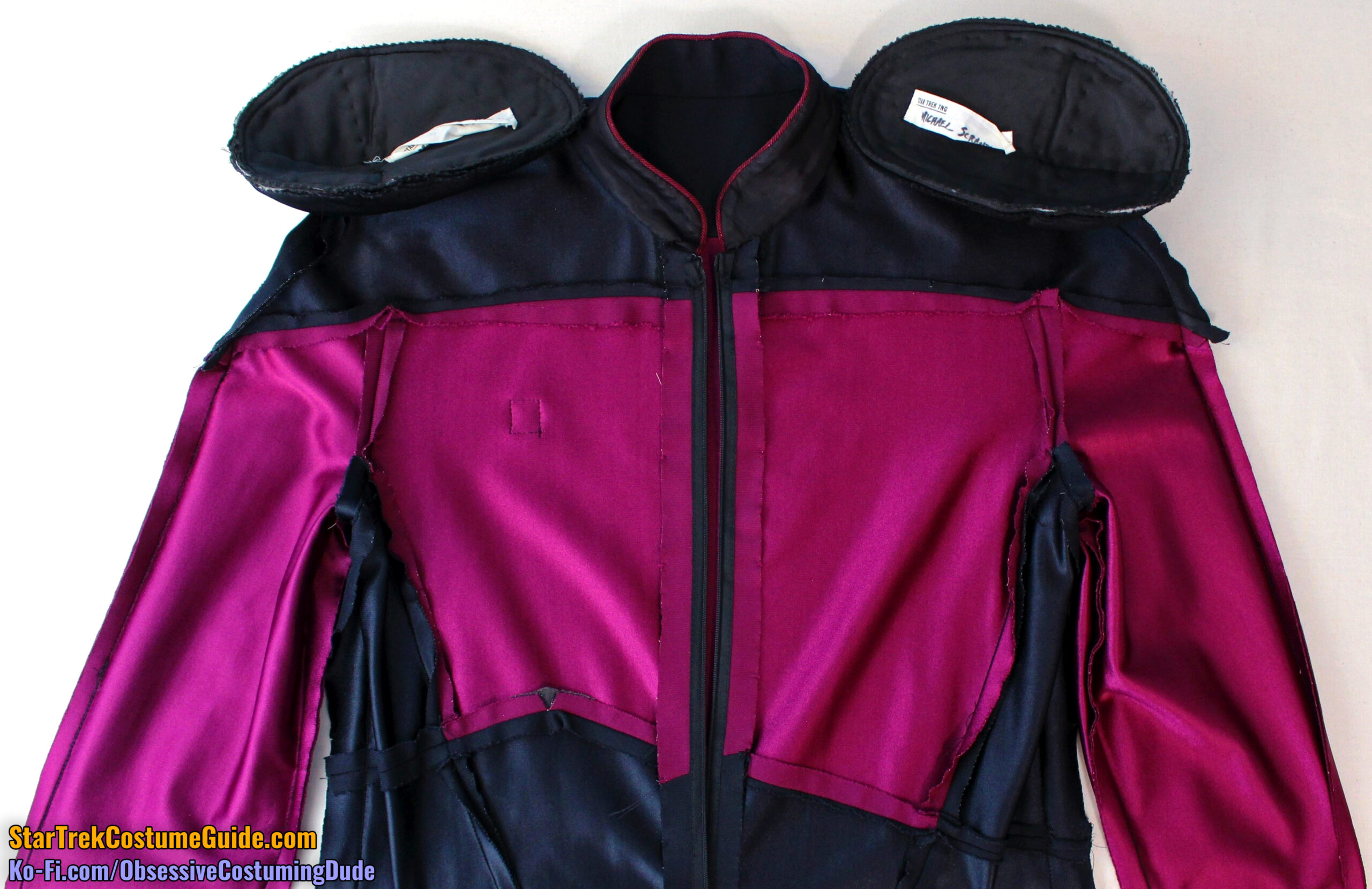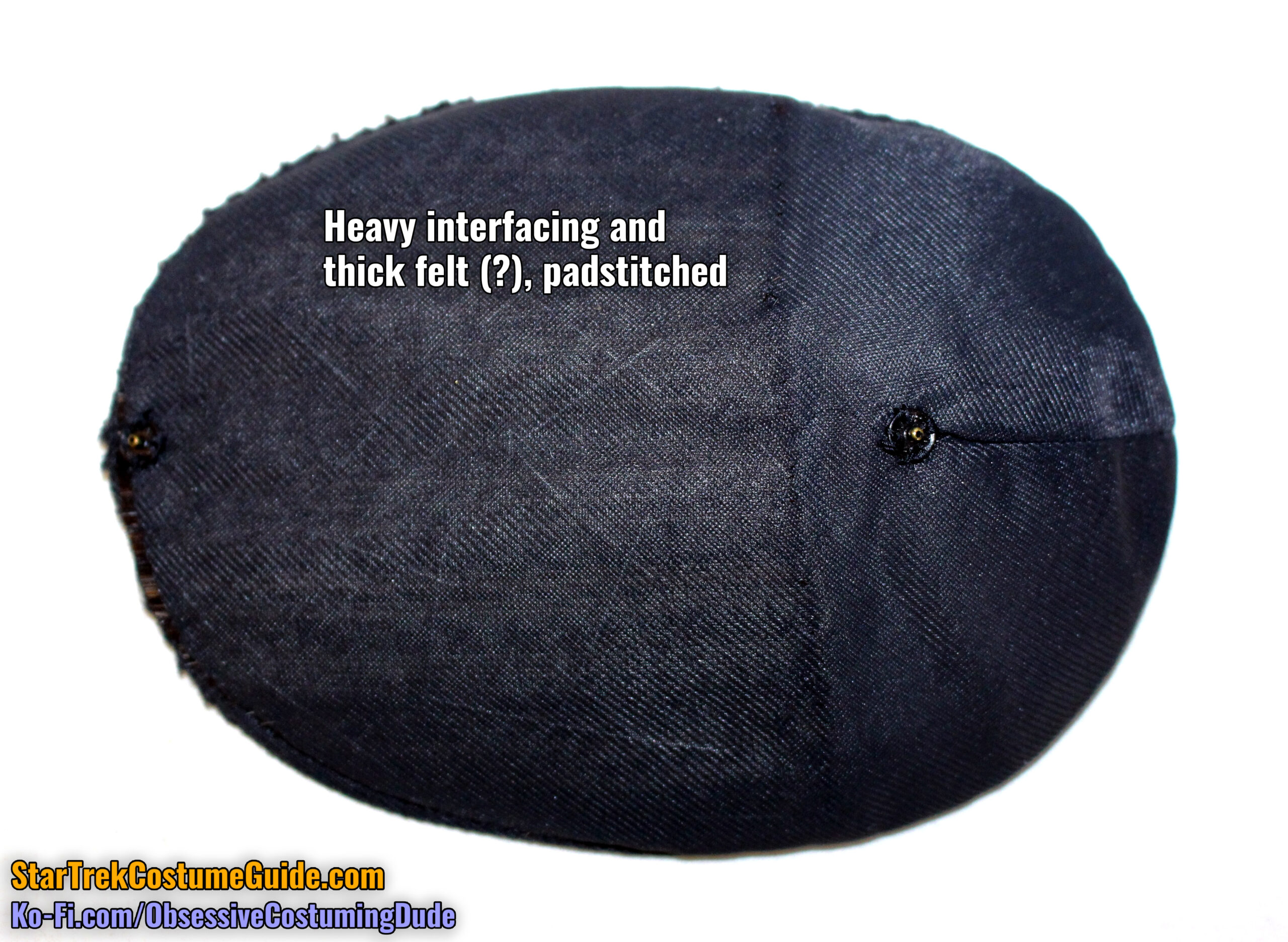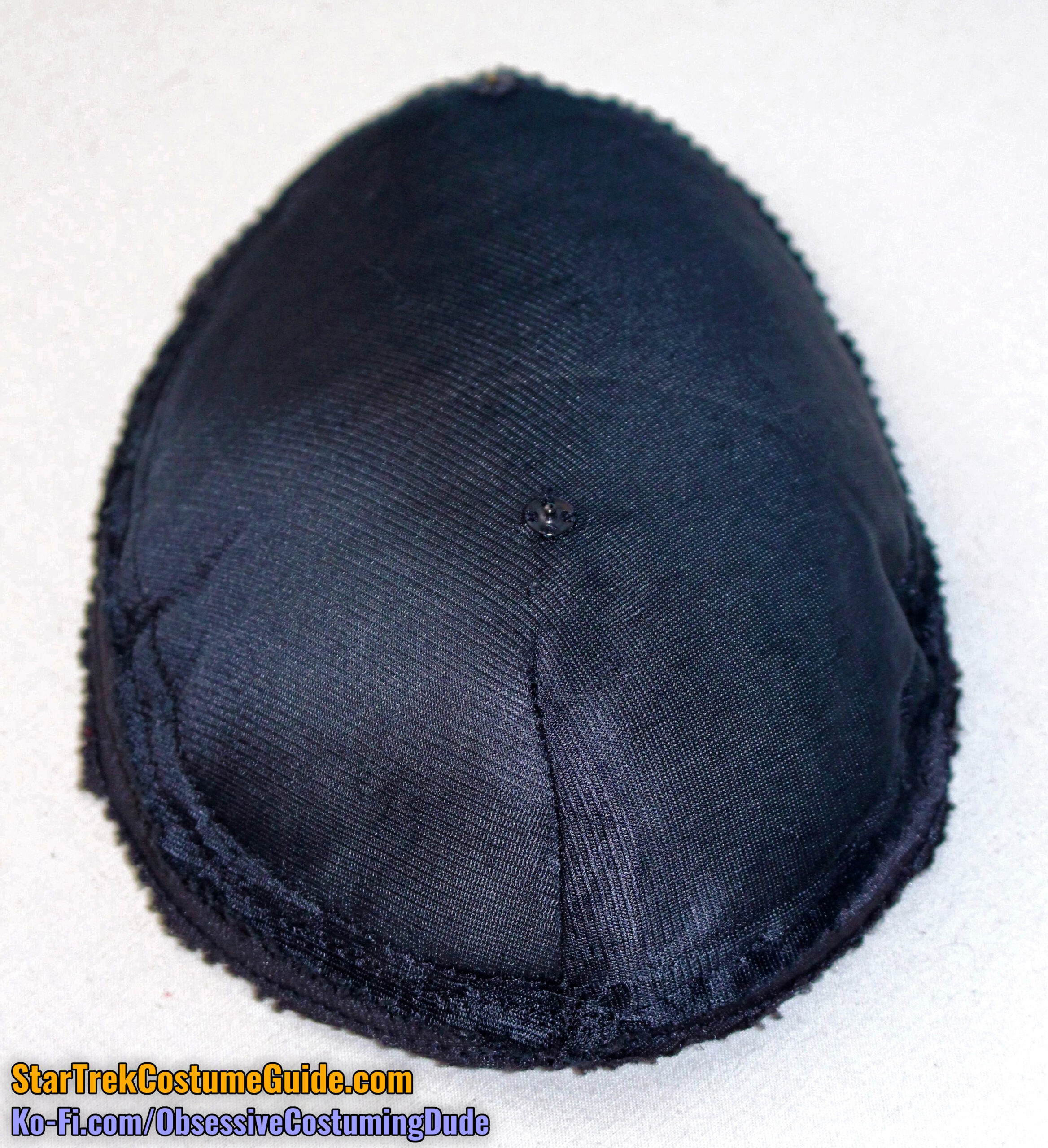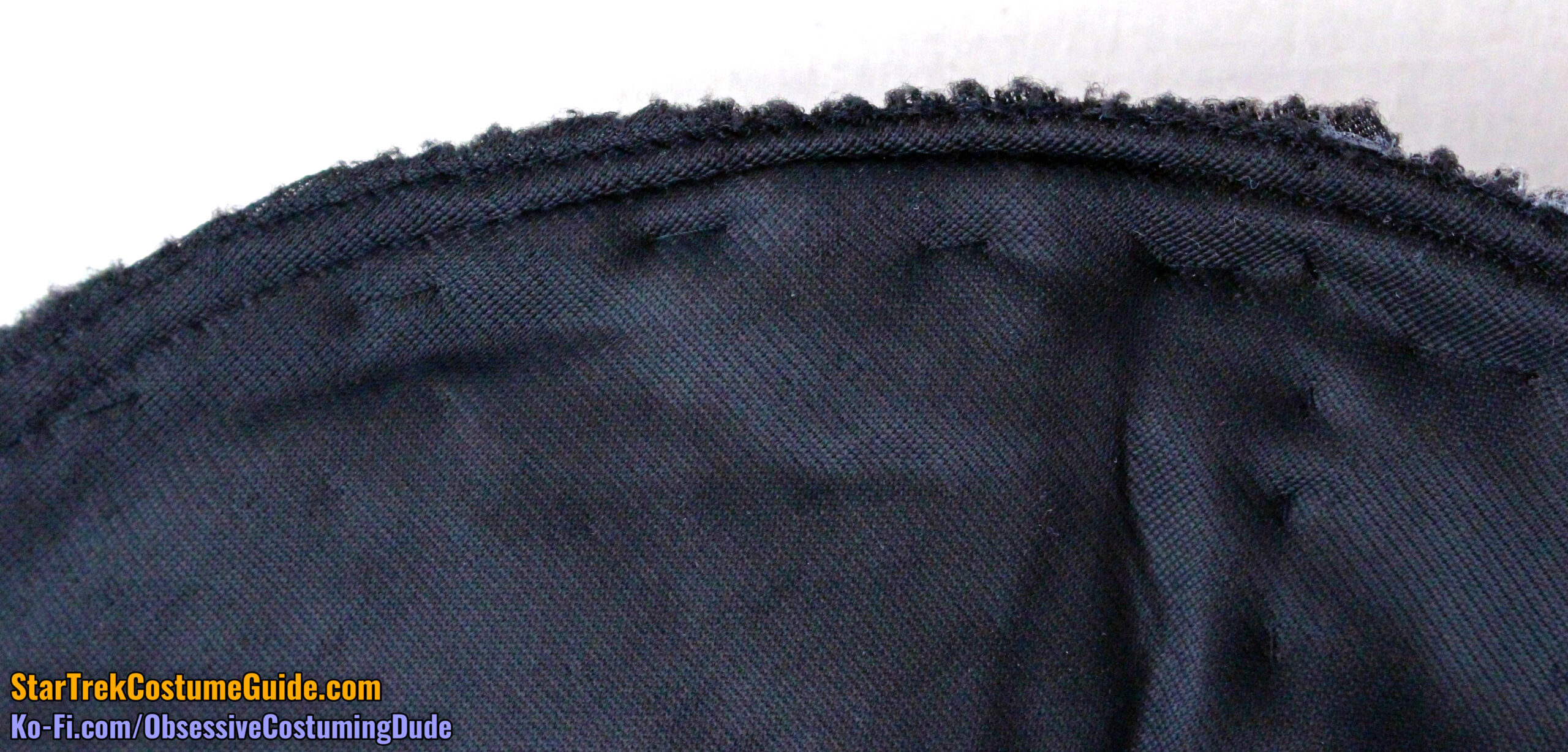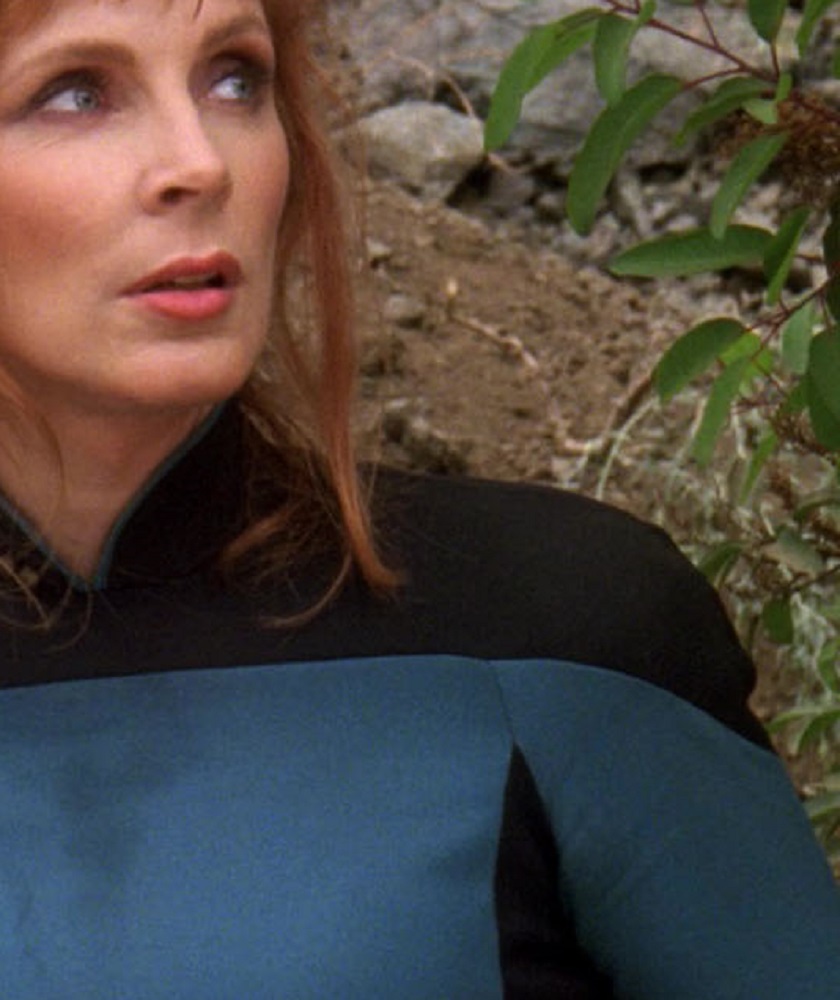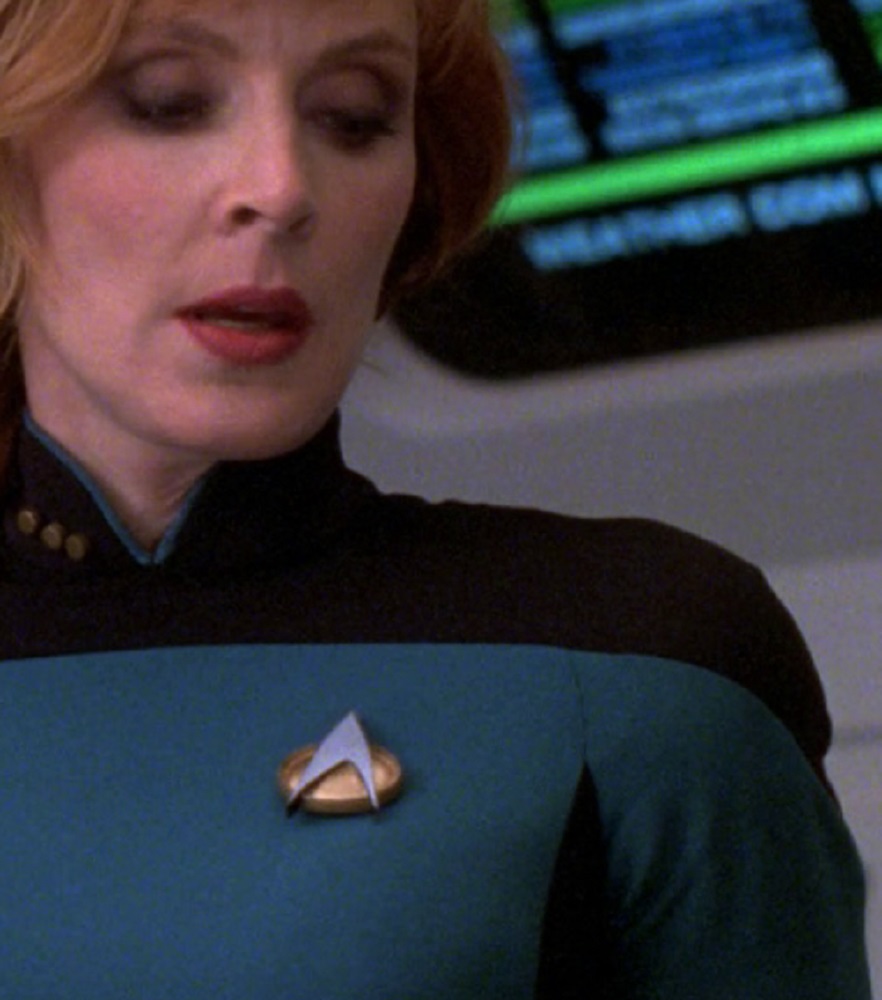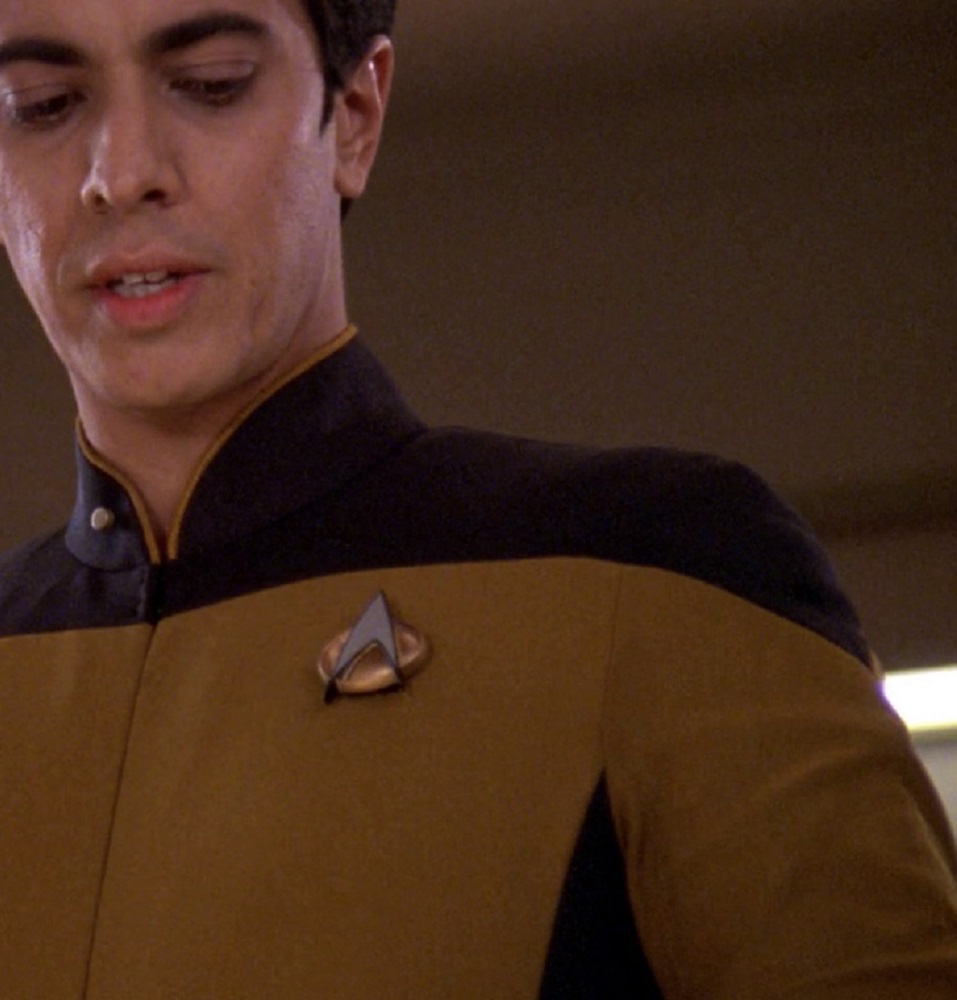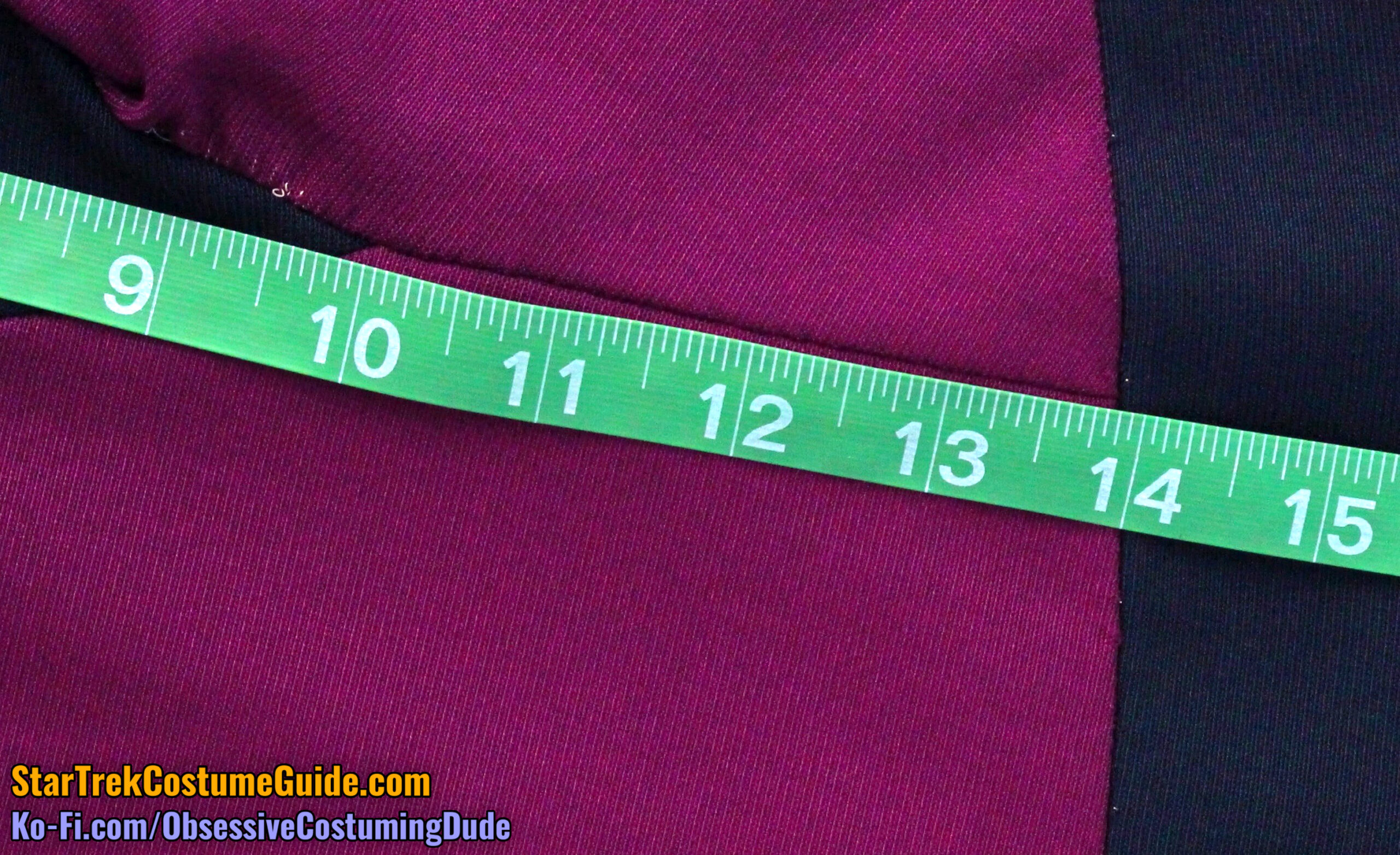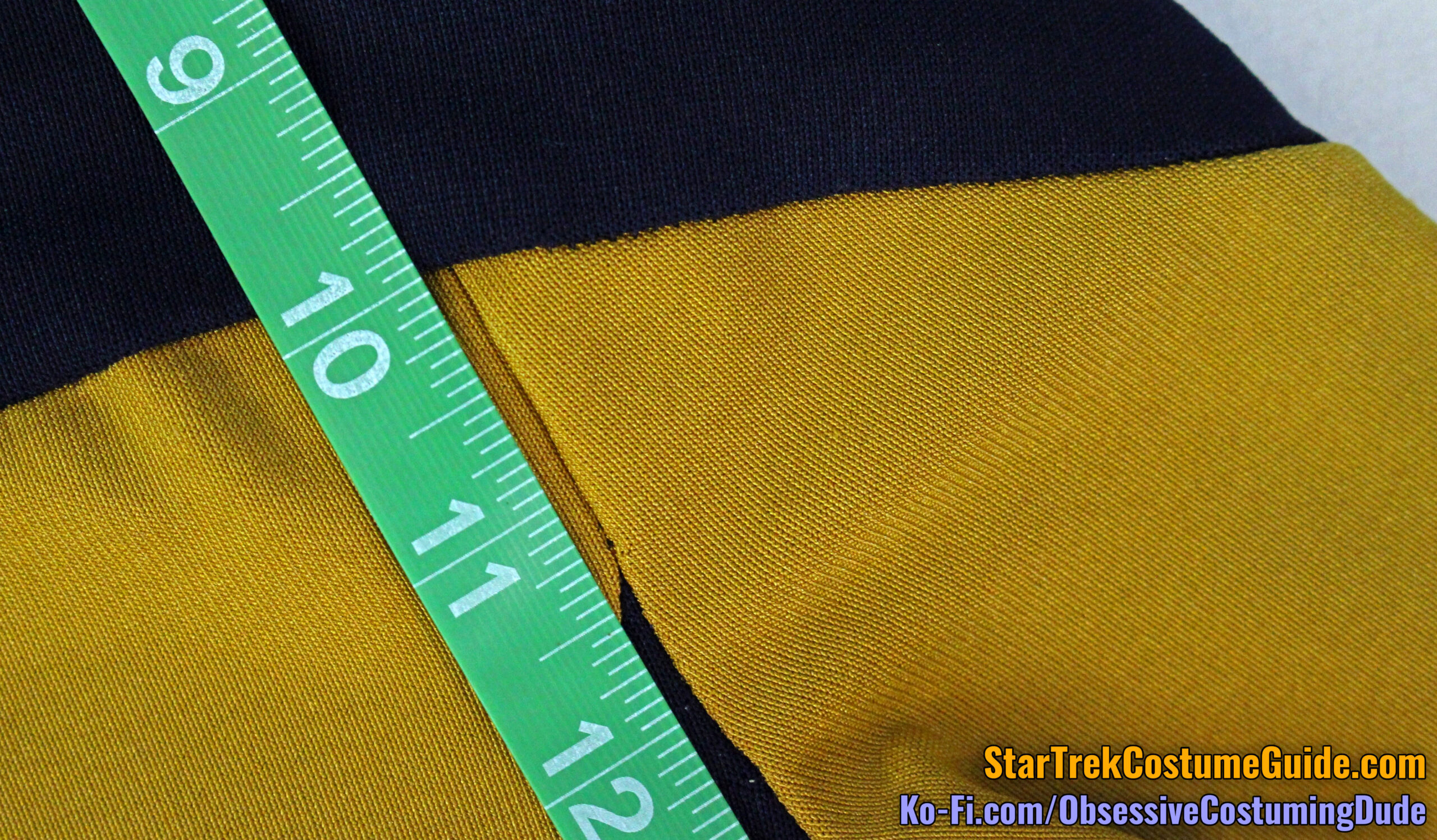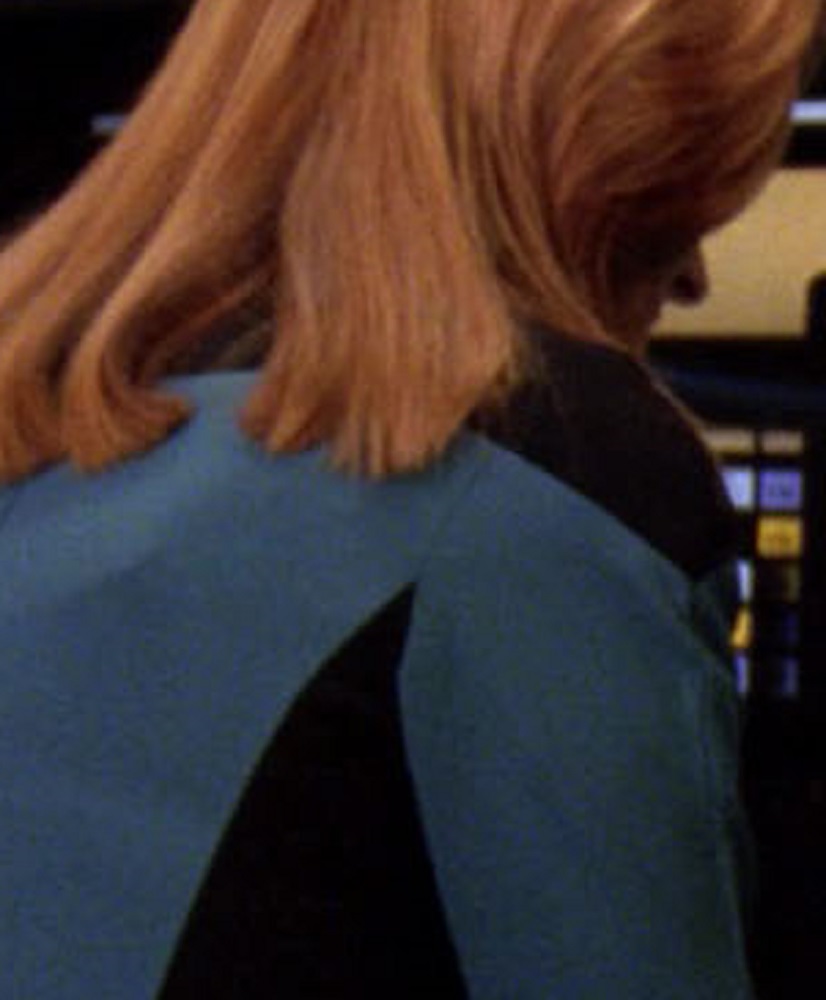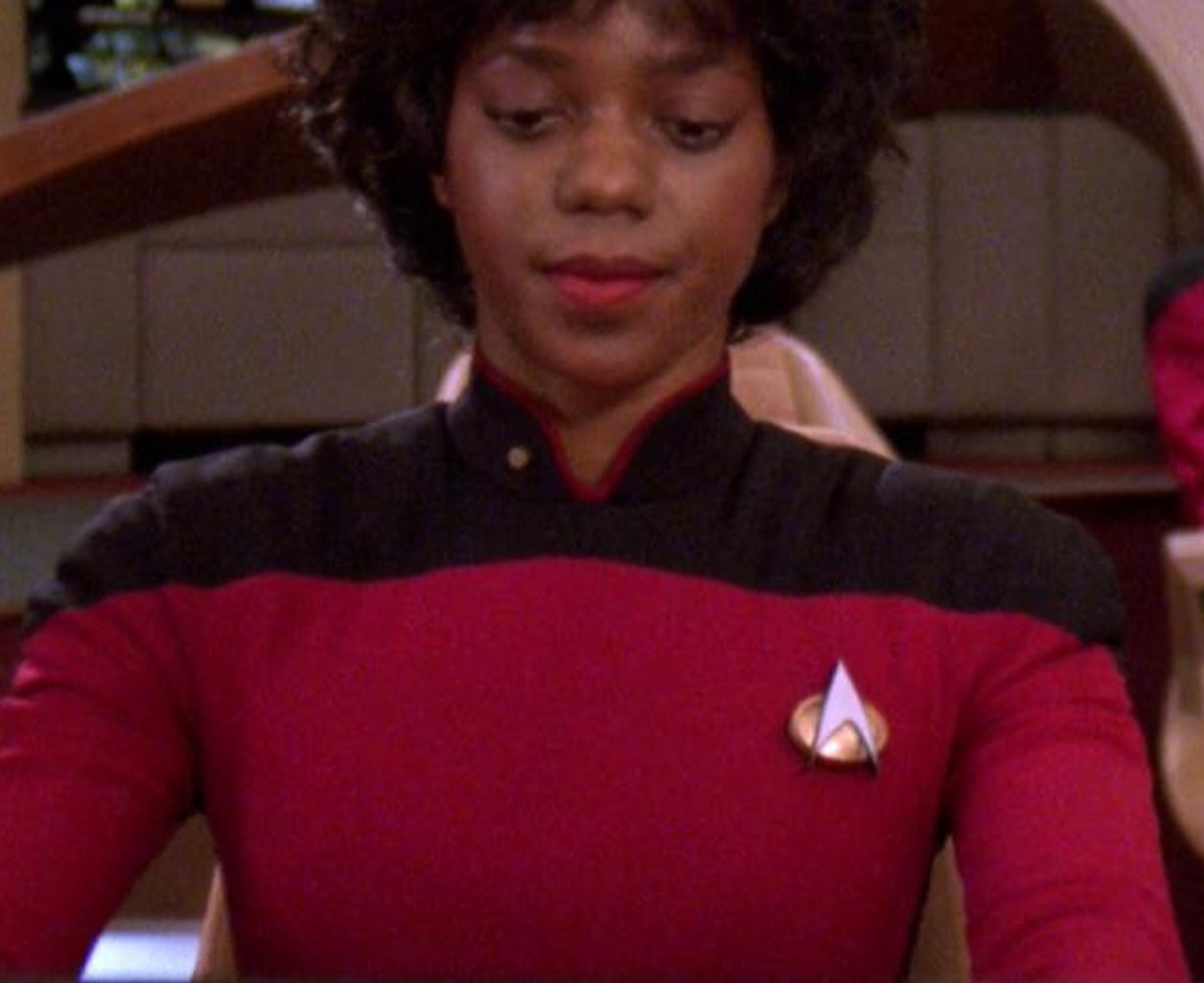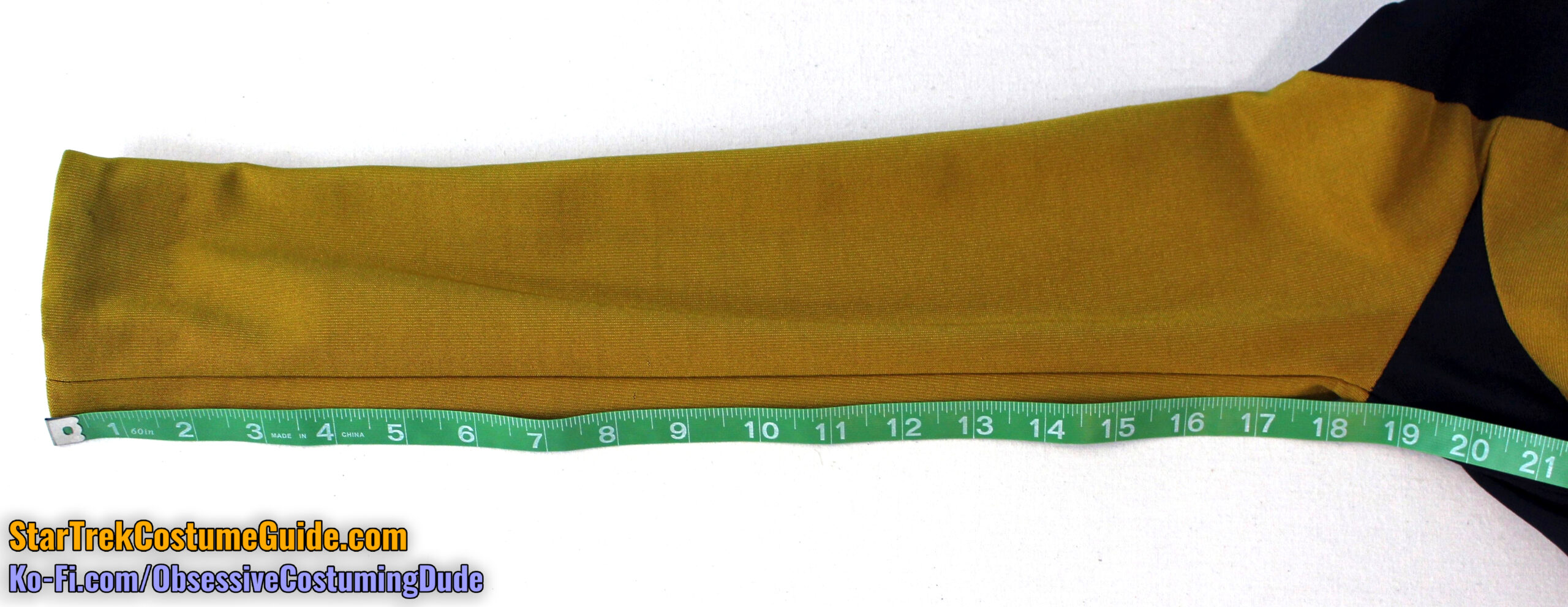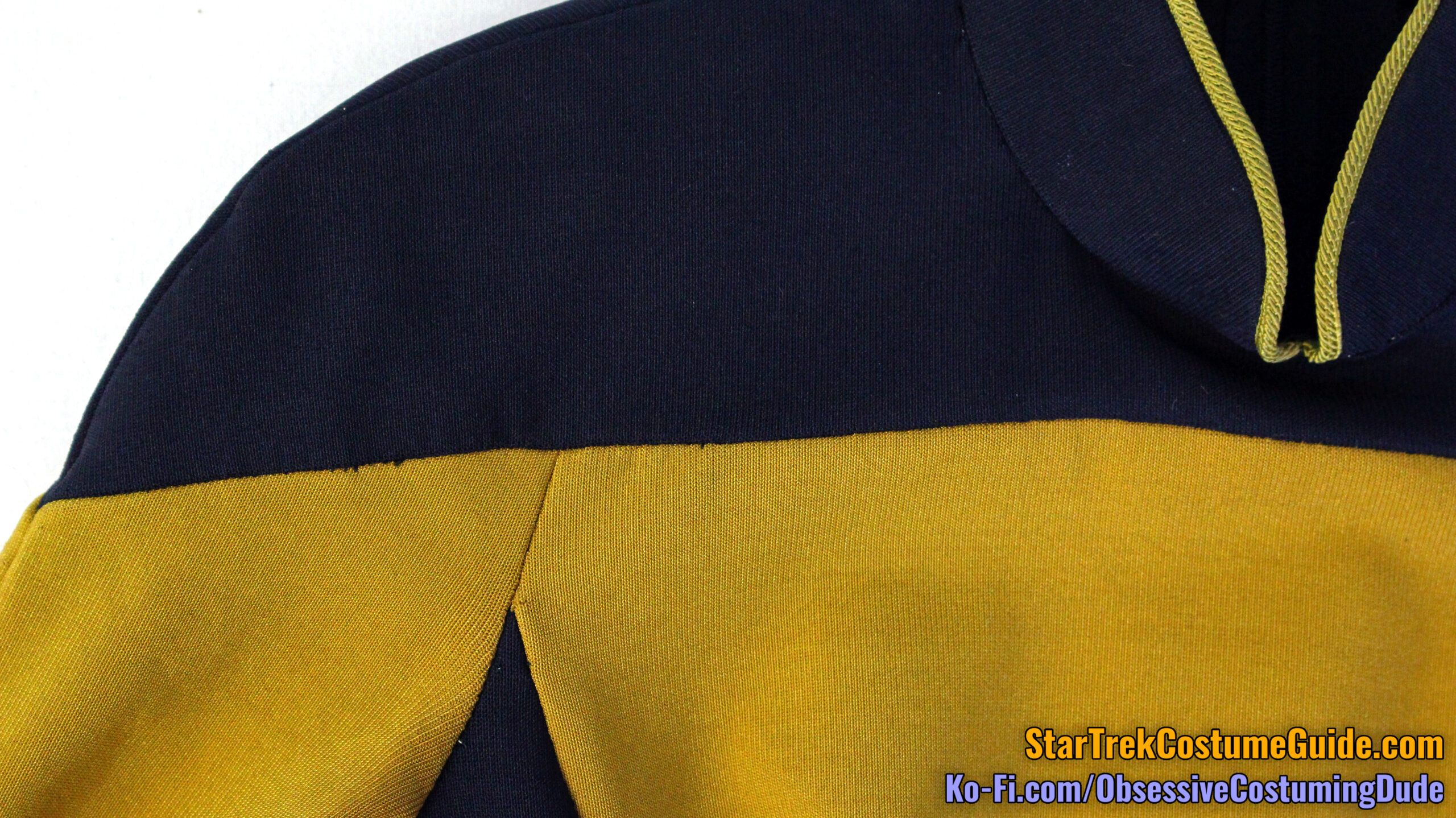Silhouette and Shoudler Padding
The TNG jumpsuit yokes extended onto the upper sleeve area with no traditional armscye seam, supported by raglan-style shoulder pads to produce a gently-rounded silhouette over the shoulders.
Both of the later-era TNG jumpsuits I examined included shoulder pads.
These pads were similar in construction to those on the screen-used TNG skant and screen-used season 1 admiral uniform I examined, although there were some notable differences.
These pads attached and detached via small snaps sewn onto the jumpsuit shoulder seam allowances.
As you may recall from my other screen-used costume examinations, the early TNG-era shoulder pads appear to have been consistently made with black lining fabric and plain batting.
However, the shoulder pads for the later TNG jumpsuits were made with a heavier, more durable fabric – polyester gabardine, perhaps? – and heavily structured.
There were multiple layers of interfacing and padding inside the shoulder pads.
The centermost two-thirds or so of the pad (the area closest to the neck) was interfaced with a very heavy, unknown material.
Observe the padstitching inside the shoulder pad, to help establish its shape.
Whatever this interfacing was, it was both stiffer and heavier than heavyweight French canvas.
I think it may have been an upholstery fabric of some kind, or possibly a utility material not intended for sewing at all; little strands of the “interfacing” poked through the outer stitching, which were quite sharp and actually appeared metallic.
On the screen-used male extra’s TNG jumpsuit I examined, the neckline edges of the interfacing were actually bound (presumably for the wearer’s protection) inside the “shell” fabric.
In addition to the interfacing (?) and padding, the outermost few inches of the pad was also structured with what seemed like thick felt.
The shoulder pads with both uniforms had the ubiquitous outer darts, characteristic of TNG-era shoulder pads.
These darts pulled the pads from flat ovals into their raglan shape.
As best I can determine, the shoulder pads for the later TNG-era jumpsuits were consistently made this way.
On the screen-used male extra’s TNG jumpsuit I examined, the shoulder pads were actually double-layered; they were literally two shoulder pads stacked on top of each other and hand-sewn together around the edges.
Considering that particular jumpsuit was a heavily-altered extra’s uniform, my guess is that that particular actor needed some extra padding to fill out the shoulder area.
These shoulder pads generally helped smooth over the shoulder area, where the yoke extended onto the sleeves.
Sometimes a slight “divot” could be seen toward the top of the sleeve, just beneath the outer edge of the pads.
Of course, humanoids come in all shapes and sizes, which may have affected the loft of their shoulder padding.
Other cast members (most notably, Counselor Troi) had more “square” shoulders, which would’ve presumably also required less padding.
(And as you’ve already seen, at least one extra was fitted with double-layered shoulder pads.)
Ideally, the combination of custom patterning and shoulder padding produced a finished costume well-fitted to the actor, with yokes so perfectly smooth they looked “sculpted” to the wearer.
However, as I learned while drafting my own TNG jumpsuit sewing patterns, this unusual yoke/sleeve paneling required precise patterning for the jumpsuit shoulders to drape smoothly. (I can personally attest to how challenging this can be to achieve.)
Upper Front Armscye
The black side panels didn’t extend all the way up the armscye to the yoke, on either the front or back of the jumpsuit; the upper corners of the side panels were separated from the bottom edges of the yoke by a bit of division-colored fabric across the armscye.
On the screen-used Ensign SIto TNG jumpsuit I examined, the upper front armscye seam only measured about 1 ¼”, which was consistent with what we saw of her uniform in the show.
On the screen-used male extra’s TNG jumpsuit I examined, this seam was significantly larger – about 4”.
While it’s natural to assume the men’s would be slightly larger, by now it should also come as no surprise that the upper front armscye seams varied in length – even on the same characters.
From season five onward, her jumpsuits’ upper front armscye seams were tightened even more, more akin to those on the aforementioned Ensign Sito uniform.
The upper front armscye seams on Counselor Troi’s jumpsuits were consistently deeper.
The mid-series guest characters’ jumpsuits often had moderately deep front armscye seams – perhaps 2” to 2 ½”.
During the later years, jumpsuits worn by guest characters tended to have tighter upper front armscye seams.
During the later years, jumpsuits worn by guest characters tended to have tighter upper front armscye seams.
The male extra’s jumpsuits tended to have significantly deeper front armscye seams (probably because so many of them were modified early jumpsuits), but they still varied quite a bit.
Upper Back Armscye
On both of the later TNG jumpsuits I studied, the upper back armscyes were very close in size to those on the upper front.
On screen-used Ensign TNG jumpsuit I examined the upper back armscyes were slightly different on each side, but still close.
The upper back armscyes on Counselor Troi’s jumpsuits were again noticeably deeper, although it looks like they may have been slightly tightened for her season seven uniforms.
The upper back armscye on Ensign Leffler’s jumpsuit was also noticeably deeper than that of Ensign Ro’s.
Extras’ jumpsuits tended to have deeper upper back armscyes, although again, that may have been because so many of them were updated uniforms from the early seasons.
Part of why I prefer to primarily base my observations on “hero” uniforms (and to a lesser, but still significant degree, prominent guest stars) is because of how much the extras’ costumes varied.
For example, here are two extras wearing jumpsuits with significantly different upper side back armscyes.
Lower Armscye (Underarm)
It looks like her jumpsuit armholes were raised slightly for the seventh season, though.
Counselor Troi’s jumpsuit armholes looked moderately deep.
The jumpsuits worn by Commander Shelby, Nurse Ogawa, Ensign Ro, and Lieutenant Commander Darren all had fairly high armholes.
Many – perhaps most – of the men’s jumpsuits had very deep armholes, although this could again be the result extras being primarily attired in modified early jumpsuits.
Sleeve Seams
The TNG jumpsuit sleeves were comprised of two pieces, although not the “traditional” two-piece sleeves commonly seen on suit jackets, blazers, etc.
Instead, the two seams were along the outermost and innermost sides of the sleeve, forming front and back sleeve panels.
The outer sleeve seam aligned with the yoke’s shoulder seam and extended all the way down to the hem.
The inner sleeve seam began directly at the bottom of the armscye (“underarm”) and aligned with the jumpsuit body’s side seam.
Sleeve Grain
As best I could determine, the later TNG jumpsuit sleeves were typically cut on the same grain as the jumpsuit body; since most of the jumpsuits themselves appear have been cut on the crossgrain (with the spandex “weave” horizontal), most of the corresponding sleeves were as well.
TNG jumpsuits cut on the straight grain (stretching around the wearer’s body, with the spandex “weave” vertical) seem to have been rare, but on the ones I’ve seen the sleeves were likewise cut on the straight grain.
However, like with some of the early TNG jumpsuits, at least some of the later TNG jumpsuit sleeves were cut on a strong diagonal (but not the true bias).
Special thanks to Casey Hardy for providing those reference photos of her later TNG jumpsuit!
I don’t know how prevalent these diagonally-cut sleeves were, although some of them could doubtless be attributed being early TNG jumpsuits (with diagonally-cut sleeves) that were later modified.
However, at least some of the uniforms specifically made during the later seasons (such as Casey’s, pictured above) had diagonally cut sleeves, so Blackman may have wanted to give them a try … or it could’ve simply been a case of the cutter(s) in the costuming department not realizing that sleeves weren’t supposed to be cut in that direction anymore.
For what it’s worth, my TNG jumpsuit sewing patterns include grain lines for all three orientations. 🙂
Sleeve Hem
Like the pant legs, the sleeve hem allowance was simply pressed upward and hand-sewn into place – although this hem was sewn with division-colored thread.
The sleeve hem on the male extra’s TNG jumpsuit I examined was hand-sewn with hem stitching rather than catch-stitching.
The sleeves on the screen-used Ensign TNG jumpsuit I examined actually had separate, sewn-on hem facings, with the lower seam line rolled under slightly and understitched.




